How to get rid of beavers? (Humanely)
 Destructive beavers are hazards to your ponds and trees. Unable to keep their teeth off of the marine life and wood, beavers can become annoying intruders.
Destructive beavers are hazards to your ponds and trees. Unable to keep their teeth off of the marine life and wood, beavers can become annoying intruders.
But, we don’t want to kill beavers; even the state doesn’t permit it!
Let’s embark on the journey of a humane beaver-control plan.
We should not forget about the ecological importance of beavers. Beavers are known as ‘ecosystem engineers’ that habituate both land and water bodies making them favorable for living.
Additionally, a 2018 research study reveals that beaver ponds are helpful in mitigating the impacts of soil erosion and pollution from the agricultural landscapes.
Therefore, it’s always better to repel beavers from your property or relocate them rather than hunting down the endangered species.
To ease your trouble, this beaver control guide will help you repel beavers efficiently, keep reading:
Identifying a Beaver Presence in Your Surroundings:
How do you know if beavers are on your property?
Beavers, like most rodents, are nocturnal, leaving behind traces of their destructive activities.
Beavers cut trees and remove bark with their sharp teeth. So, if you see signs of tree destruction, lake or pond damming, prepare to set your traps.
6 Ways to Get Rid of Beavers:
Here’s what you can do if you think the destructive critters are sneaking around on your property:
- Try Beaver Repellents and Deterrents:
The first step to any rodent removal is applying repellents on the vegetation in your yard. However, studies by the National Wildlife Research Center reveal that beaver repellents have a short-term effect on beaver control. Therefore, it should be reapplied often.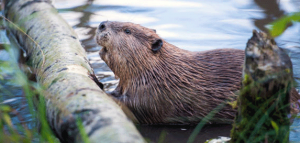
Unfortunately, when nothing is left to eat for the beaver, he wouldn’t mind eating a few repellent-treated plants.
Repellents prepared with natural ingredients such as hot sauce work perfectly. The repellent works great for cottonwood but is useless for red cedar.
Alternatively, a few chemical repellents can work effectively. For that, you need to determine how much quantity is necessary for shrubs and trees.
As for the deterrents, you can try strobe lights, sirens, and even propane cannons.
Beavers are cautious, nocturnal animals. Therefore, the critters become cautious when visual and audible deterrents are used together. Bear in mind animals can get used to these tricks.
- Fencing:
Beavers are instinctively attracted to the trickling sounds of water. This compels them to dam it up.As per the Association for the Protection of Fur-Bearing Animals, there was a need for a non-lethal approach to ward off beavers from ponds. This led to setting up exclusion fences.
Fencing is a workable solution if you have a pond with marine life in it. Fencing is a surefire way to keep your pond fish safe because beavers are not climbers. It also prevents them from damming up in ponds. Set up a wired fence of about six feet to keep the critters out.
You can also set up a drainage system to make the dam/pond water leak, making the progress of beavers difficult.
- Fence Around Trees and Branches:
Tree barks provide beavers with construction materials.If you fence up the trees, shrubs, and branches, or the entire yard area with mesh wire, it would be difficult for them to build dams. Also, clear up the surrounding area of any fallen branches. They will eventually move on due to the non-availability of construction materials.
This is an environment-friendly way to keep the beavers away without causing harm. However, this cannot be a considerable option for wider areas, especially if the beavers have already habituated the place.
- Electric Fencing:
For larger areas, electric fencing is a highly effective solution to repel beavers. High-tensile electric wires can be erected to about 4 inches above ground level.The wires deliver a mild shock to beavers in their nose or head region as they approach the vegetation for construction material or damming. It needs to be done very professionally.
Also, the electric supply should be checked regularly to ensure beavers are constantly repelled from the area.
In terms of maintenance, you need to remove any fallen limbs near the wire or weeds, or grass growing beneath it. If they come in contact, there is a chance of a short circuit and fire.
So, this is a tricky method requiring maintenance for protecting the lands of armers from beaver intrusion.
- Set Up the Traps:
First, find out how many beavers regularly visit your property. Because buying a bunch of traps when there are only two or three of them is wasteful. Then, set a clamshell trap near the area they are habituating. Clamshells are effective traps to secure the beavers well after they are caught.If you are unfamiliar with beaver traps, learn about the different traps available and how to set them up without causing any harm to the beavers. This is a necessary step for non-lethal trapping. Beavers may not appear dangerous but it is better to approach them only when they are caught. Otherwise, there is a greater chance for them to attack and hurt you.
- Exclusion:
Exclusion refers to methods of making the habitat inhospitable for beavers. Now that you have relocated the beavers, you should destroy their previous dwellings. Also, hide away the material they had used. This is important to discourage them from returning.Sometimes, the trick works well in the first go. But, a stubborn beaver may return to rebuild.
Therefore, continue to destroy their dams, remove the materials, spray a few repellents and utilize deterrents. They will eventually get the idea of how useless it is to build up dams in your area.
Final Verdict:
No matter what, beavers are ecosystem engineers and they deserve to live. Considering they are an endangered species, it is important not to harm them but to scare or repel them away from your property.
How to Trap and Relocate a Beaver?
‘Nuisance’ beavers, the natives of North America, often come in conflict with farmers and residents living near bodies of water.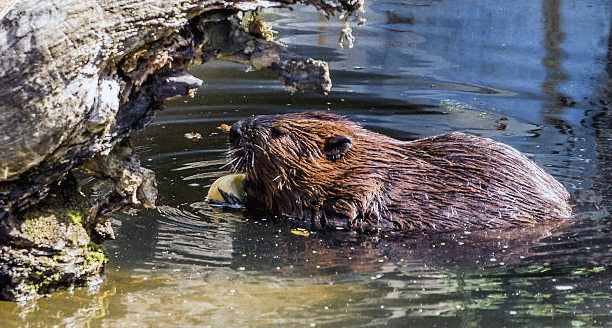
Beavers have an addiction to building dams that pool up the water of streams and lakes. Basically, it’s their natural, innate behavior.
Sometimes, this can lead to unwanted floods and destruction of vegetation.
In several cases, nuisance beavers are hunted and killed for their actions, which is illegal, especially where the beaver population is extinct.
Therefore, it’s necessary to eliminate beavers in a humane way.
Ecological Importance of Beaver Behavior:
It may appear annoying to us when beavers destroy our vegetation, but they do it for a healthy wetland and forest ecosystem.
By building lodges and dams, beavers prove themselves as ecosystem engineers because they are the reason behind increasing water levels, slowing down water flow, and changing water direction. This improves water quality and diversity in the wetlands.
Therefore, if you wish to relocate beavers, you should look for a suitable habitat that has sufficient food and shelter.
Locate the Beaver Activity:
Before setting up traps, become aware of where the beavers habituate and the amount of damage they are causing. Knowing the places they frequent, you can target specific areas for trapping.
Damming can increase the chances of flooding nearby fields via irrigation systems. Therefore, identify them before time runs out.
Commonly, beaver activity is identified from pathways, beaver lodges, cut-down trees, beaver dams, and flooding.
Initial steps should be based on non-lethal methods of beaver removal. Often, trapping is not considered humane in a lot of ways.
Problems with Beaver Trapping:
Live trapping turns out to be the last resort when all else fails. Especially in the case of large vegetation areas, fencing isn’t a workable solution.
Live traps should be set up quite strategically and monitored regularly.
Sometimes, trapped beavers or other species can die due to stress or hypothermia after being caged for too long.
Unfortunately, many of the available beaver traps are lethal and can kill beavers inhumanely.
Conibear traps, foothold traps, and snares are inhumane beaver traps. Conibear traps are most commonly used as fast beaver traps.
Conibear traps are deadly. They can cause an instant kill by snapping the trapped animal’s neck.
Studies reveal that fewer than 15% of animals trapped die on the spot while over 40% of the animals die an inhumane and painful death, crushing their heads or sometimes abdomen.
Moreover, the Conibear trap is non-selective; so it can catch raccoons, eagles, or dogs instead of beavers.
Even children and pets get injured by the traps. And as it is difficult to open the trap, often pets die trapped due to the failure of the owner to release it.
Live trapping and relocating without harm requires professional help.
Consequences of Relocating Beavers:
Relocating beavers can have several consequences for the beavers:
Even if they are relocated, they will become a nuisance for the new surrounding populations. If other beavers are already residing in the new place, survival conflict can arise. This may lead to the killing of the beaver as well.
Moreover, in most Canadian states, relocation can only be done for up to 1 km from the main site. This makes it easier for the beaver to return to the original location.
Young beavers are dependent on their parents for survival. If the parent beaver is relocated, the orphan beaver’s survival is extremely compromised. You may have to look for a rehabilitation center to make the little ones’ survival possible.
Is Lethal Trapping an Ultimate Solution?
In simple words, neither is it legal nor is it a permanent solution. Beaver lethal trapping is not permissible in places where beavers are endangered.
Moreover, the inhumane killing of ecosystem engineers is unethical. The furry animals are only doing what they are born to do, intending no harm to humans.
Furthermore, killing is not a permanent solution. When the previous beaver leaves a space, another beaver will find the habitat suitable and make it its new home.
For beaver removal, some people go to the extreme extent of breaking up the entire beaver dam. But, the beavers are quite stubborn and hardworking. They will start building it up again.
A Few Dos and Don’ts of Beaver Control:
Dos:
- Do implement all the possible non-lethal options before deciding to trap and relocate beavers. Trapping can get expensive and even be lethal for beavers.
- Do consider how much trouble the beaver is really creating. If it’s limited to a small pond or lake away from your space, let it be. However, discourage their intrusion into your space the first time they appear on your property.
- Do acknowledge the educational, ecological, and recreational benefits they are offering to our environment.
- Do implement more than one method of beaver removal together and be consistent in destroying their dams in your ponds/streams until they give up.
- Do seek professional help for beaver management if you cannot handle it on your own.
Don’ts:
- Don’t use lethal traps or inhumane methods of killing beavers.
- Don’t relocate beavers in unknown, non-vegetated places where their survival is challenged. In fact, relocation can put the animals under stress and can lead to their death.
What Can You Do to Trap and Relocate Beavers Safely?
The most workable solution is seeking professional help for safe trapping of beavers. Afterward, they need to be relocated to a place with an ample amount of vegetation and water. Make sure the weather conditions are sustainable for beavers as well.
Let them freely continue their job in the new habitat. Relocating beavers, by no means, refers to making them compete for their survival in unknown lands.
On the contrary, if you think you can tolerate a little beaver nuisance in your vicinity, let them continue to be by your side.
How to Keep Beavers from Chewing My Trees
and Damaging My Property?
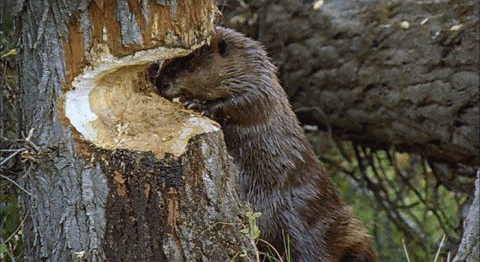
Beavers need wood to craft their habitats in waterbodies. These critters are skillful in transforming freshwater surroundings—lakes and ponds—into an amiable habitat.
When they reside in a certain vicinity, they continue to collect wood and dry building materials to build a safe home. Construction is a never-ending process for them.
Although beavers are not necessarily harmful, you should get rid of them before they get comfortable on your property. They may end up destroying the vegetation you have. Wholoves a destroyed yard when it takes years for the beautiful trees to grow?
Beaver problems have long been dealt with using several control plans such as trapping, repelling, habitat destruction, relocation, and fencing.
If beavers are causing damage to your trees and shrubs, nip the problem at its bud before the beavers get too comfortable:
How to Know if Beavers are Destroying Your Property?
Is it just a storm or beavers? Can’t find a trace of pond habitation? Then, it might not be the beavers.
Beavers are nocturnal animals that are attracted to water bodies. In fact, they are instinctively drawn to the dripping sound of water. They are ready to work hard, collect thebuilding materials, and construct a dam in ponds and lakes.
These critters can pose a problem when they start collecting wood from your garden. Having sharp, pointed teeth, they can masterfully cut through tree bark and remove them.
Though not seen during the day, you can sense their presence from the destruction they have caused. They can destroy trees for building materials and use your property as a food source.
Further, beavers can spread diseases such as rabies and parasites, which can cause blindness and liver failure. They can pass it on to you through your pets or direct bites.
To counter that, prepare yourself to get rid of them before it’s too late.
What Do Beavers Feed On?
It’s crucial to know what beavers would particularly target as food and wood sources.
Beavers prefer trees such as birch, alder, poplar, maple, willow, and cherry. They may also feed on the twigs, leaves, and bark of these woody species of plants. In summers, beavers can also munch on pondweeds, water lilies, and cattails.
In fact, beavers can travel up to 3 to 4 miles from streams and ponds to get to woody trees. They usually target soybean and cornfields, where they pluck the tree from its roots to carry it back to their habitat.
They either feed on certain plants or use them to build dams and lodges. So, it’s challenging to keep them off of your fields.
Methods to Prevent Beavers from Damaging Your Property:
Beavers are ecologically important for agricultural lands, preventing erosion and pollution in those areas.
In some areas they are an endangered species. This makes it imperative to remove them from your property in a humane manner.
Here’s how you can stop beavers from damaging your property:
- Effective Repellents for
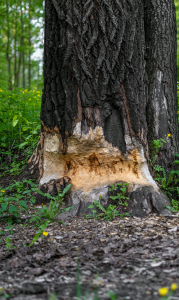 Beaver Removal:
Beaver Removal:
Repellents, in general, aren’t very effective against beavers. When the beaver is hungry and it has nothing to eat, nothing can come in its way—even the distasteful repellent-flavored leaves.Moreover, repellents need to be reapplied after every 6 to 7 days or a rainy day. Some repellents contain Thiram, an effective beaver repellent. Yet, it is moderately toxic through nasal, oral, and dermal exposure and can cause eye or skin irritation. Possibly, it can cause fetal malformation as Thiram is a neurotoxicant.
What’s safe and effective is a sand and paint mixture. Wrapping trees with the mixture is a better way to repel them from chewing vegetation.
- Inhospitable Surroundings Discourage Beavers:
You can make the area inhospitable for them to discourage their return. You can set up mesh wire fences around the area and trees that are high enough for them to climb. Beavers are not climbers but they need wood for damming up ponds and lakes. When you make the wood inaccessible to them, they may wish to leave the place.Beavers can travel a considerable distance to find wood and build dams. So, removing wood sources 3-4 miles away can become a tough task.
Another method is to set up a drainage system to make it difficult for them to build a dam in the stream. This can also discourage them from building in that space.
- Fencing is a Tried-and-Tested Remedy:
If your fields or yard is nearby the damming of beavers, you can fence your vegetation. Use about 4 feet high steel wire to protect your vegetation, including all the trees and shrubs. Or you can separately wire fence the barks of trees if they are separately standing from the vegetation area.
But, is electric fencing an option?Electric fencing is considered an effective method of repelling beavers from vegetation fields. It can prevent beavers from damaging your property.
However, care and maintenance are utmost here. Although the fencing delivers mild shocks, if the beaver gets stuck, it can prove stressful or lethal to the beaver. On the other hand, if vegetation grows close to the wire, it can lead to short circuits and even fires in your field.
Therefore, regular check-ups are necessary in case of electric fencing.
Why use electric fencing if beavers can be kept out of reach with simple fencing? - Beaver Traps are Effective In Eliminating Beavers:
After trying out everything, trapping beavers is your last resort. There are two types of beaver traps to choose from:i) Live Clamshell Traps: These are the easiest and safest to set up for amateurs. They are effective in trapping beavers from around their habituating ground quite securely.
ii) Lethal Trap: As the name suggests, this trap can be lethal if used unprofessionally. It has a large conibear body-gripping trap which can prove deadly for beavers if handled by newcomers.
Lethal traps are not recommended for usage as they can cause harm or even death to the beavers.
Unfortunately, trapping and eliminating beavers may not solve the problem. More beavers may come to take place of the previous beaver and the battle of man vs beaver continues.
Should I Seek Professional Help?
If you fail to keep beavers away using all the above methods, professional help can be considered. Employ a wildlife removal professional to handle the beaver problem.
Final Verdict:
Beavers become annoying when they start damaging your property. If a non-lethal strategy can successfully keep them away, that’s perfect. Killing them wouldn’t solve the trouble as more beavers would come to take place the place of the previous ones.
How to make my property less attractive to beavers?
The joy of every property owner is to see ensure the attractiveness of their property. The general appearance of a property determines its value on the real estate market and it even says a lot about its owner. Nobody wants to live, rent, or buy a property that is falling apart. These days, many properties are damaged and destroyed because they have been invaded by pests. On the top of the pest list are beavers. Although these animals make for good animation and children’s storybook characters, they have a nuisance side that is not being portrayed in those stories. If your property is close to a stream or pond, chances are that you may have a beaver problem.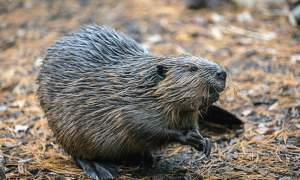 Beavers are semi-aquatic animals. This means they can live in water as well as on land. This is shown in their adaptation of both land and water habitats. This makes controlling them a bit difficult since they are excellent builders (often referred to as nature’s engineers). A beaver colony may live 3 miles from your property, cause serious problems, and you still wouldn’t be able to catch them because they build well channeled burrows and dams. They can destroy your yard and eat away at wooden fences and structures, generally making your property look unkempt. Below are some ways you can make your property less attractive to beavers.
Beavers are semi-aquatic animals. This means they can live in water as well as on land. This is shown in their adaptation of both land and water habitats. This makes controlling them a bit difficult since they are excellent builders (often referred to as nature’s engineers). A beaver colony may live 3 miles from your property, cause serious problems, and you still wouldn’t be able to catch them because they build well channeled burrows and dams. They can destroy your yard and eat away at wooden fences and structures, generally making your property look unkempt. Below are some ways you can make your property less attractive to beavers.
- Declutter
Beavers, just like the rest of the rodent family, thrive on cluttered spaces. They are able to make burrows and boreholes unseen when there is a large amount of clutter and scraps. So, when you sight a beaver, the first thing to do is to clear out your property and make sure there are no hiding places for the beavers. If you keep pets, make sure that their leftovers are not left outside as they may attract beavers to your property. If your property is located close to trees, you should cut any weeds attached to the trees so that everywhere is clean and visible. - Build a perimeter
This is more of a preventive measure. If your property is located among trees, it makes a lot of sense to build a protective fence around the trees and your property. However, beavers are known to gnaw at fences and they have even been known to cause standing trees to fall. But building a perimeter fence is still a great way to keep them off your property. Ensure that you check for signs of chewing or gnawing after installing the fences. If you notice any, replace your fencing material with stronger ones that the beavers will not be able to break into. - Take advantage of beaver repellents
Every animal has its natural repellent. Many natural and chemical repellents have been proven to work on beavers. The repellents can be sprayed on trees to discourage chewing and on areas surrounding your property. However, after a while, the potency of the repellent wears off and reapplication becomes necessary in order to ensure its effectiveness.
How to prevent beavers from building a dam?
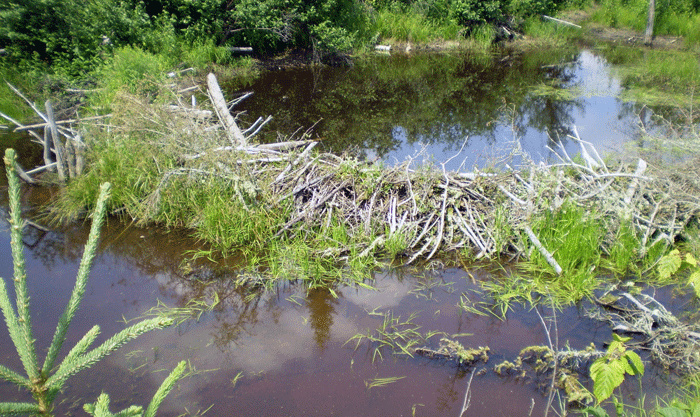
Beavers, although semi-aquatic, move better in water than on land. Thanks to their webbed feet, they are able to wallow through streams and ponds. However, this excellent adaptation makes it a little difficult to live on land. As a solution to this problem, beavers build their homes (also known as lodges) in water. They raise their children in these lodges and only swim to shore for food.
A beaver’s diet is mainly herbivorous consisting of barks and twigs, so they need to return to land for feeding every now and then. To ensure the safety of their homes and feeding places, beavers build dams around their homes and their food stores. They use these dams as a means of transporting food from surrounding bushes to the water source and as a defense mechanism against invaders coming into their homes. These dams are also used for storing food for the winter.
To achieve these dam-like structures, beavers will use their sharp front teeth to gnaw at trees and other materials and then transport them to the source of water where they use them in building the dams. Usually, sightings of these dams indicate the presence of a beaver community and this means trouble for the surrounding properties and structures as beavers can destroy properties and cause severe damage with their feeding lifestyle. If beavers have been sighted on your property or surroundings, it is best to prevent them from building dams in the area. These are some ways to prevent beavers from building dams.
- Use water flow devices to control water levels
One way to ensure that beavers do not build dams is to make sure that the water around you is constantly flowing and not stagnant. This can be done through the use of water flow devices that helps the water to flow. Flowing water makes it harder for beavers to create dams as the current repeatedly carries materials away. Beavers choose spots for creating dams based on the sounds of water flow, so, cutting off consistent water flow through the use of these devices can discourage the building of dams. - Carefully construct culverts to keep beavers out
Beavers are notorious for constructing dams in or near culverts. This can cause serious flooding problems in the surroundings. Dams constructed by beavers inside or at the entrance of culverts are more difficult and costlier to remove than dams built on open waters. Culverts can be built with wire screens and fences that discourage the invasion of beavers and permits water flow. - Remove raw materials
Beavers usually do not like to travel far from their homes. Therefore, cutting off their raw material supply will result in them not building a dam. Trees close to the area can be protected with wire meshes. Alternatively, the trees may be coated with a mixture of paint and sand to discourage chewing. Also, all twigs and other materials that can be used to build dams should be cleared out of the area.
How to control beaver dam water level?
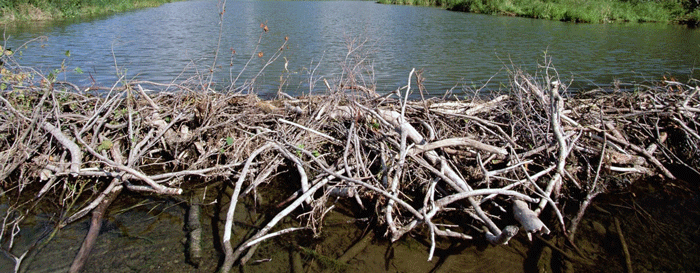
One of the favorite things beavers love to do is build dams around their homes. While these structures are important for their survival and protection, it does more bad than good to the environment around it. One of the devastating effects of beaver dams is flooding. If care is not taken to manage beaver dams around a particular location, it may cause damage to trees, natural, and man-made structures located in the environment.
When beavers make their dams, they partially or totally block the flow of water in one direction (usually the direction of their homes). This causes an overflow of water on the other side and ultimately flooding of other areas because the water must go somewhere. Residential and commercial properties in the vicinity will notice constant flooding which may cause structural damage and even mold growth on the property.
Roads are not exceptions to this as floods can cause blockage and degradation of roads. They can cause asphalt erosions which may cause ditches to form on the road and lead to accidents. Sometimes, destroying these dams is not enough as the beavers will only build them back
overnight. Since killing them is not an option in many states, one can only hope to manage them so they don’t cause wreckage to properties before the proper wildlife control authorities arrive to handle the situation. One of the ways to do this is to control the water level around the beaver dam and make sure it is not flooding to other places. Below are a number of ways to do this:
- Using a flex pipe device
Flex pipe devices help to control the level of water around a beaver dam by ensuring that the outflow of water is even. It involves the use of pipes inserted from one end of the dam to the other side. This forms a type of strainer to release the water build-up from one side of the pond to the other. Many times, water flow devices tend to fail if the beavers discover the pipe and seal it. Therefore, the pipes should be checked at intervals to make sure that everything is in order.The pipes can also be fenced after installation to ensure that the beavers do not discover and seal it. The size of the pipe used should be determined by the size of the pond. Oversized pipes in small ponds will be easily detectible by beavers. The size of the ponds will also determine how many pipes will be needed. Also, ensure that the water levels are not too lowered such that the beavers can sense an absence of water. This is so they don’t build another dam downstream where the water flows to.
- Population management
This might not seem like a viable solution, but controlling the population of beavers in a particular area will ensure that fewer dams are built and ultimately, less flooding of the surrounding areas. Without management, beaver populations grow rapidly and controlling water levels and flows becomes a problem.
